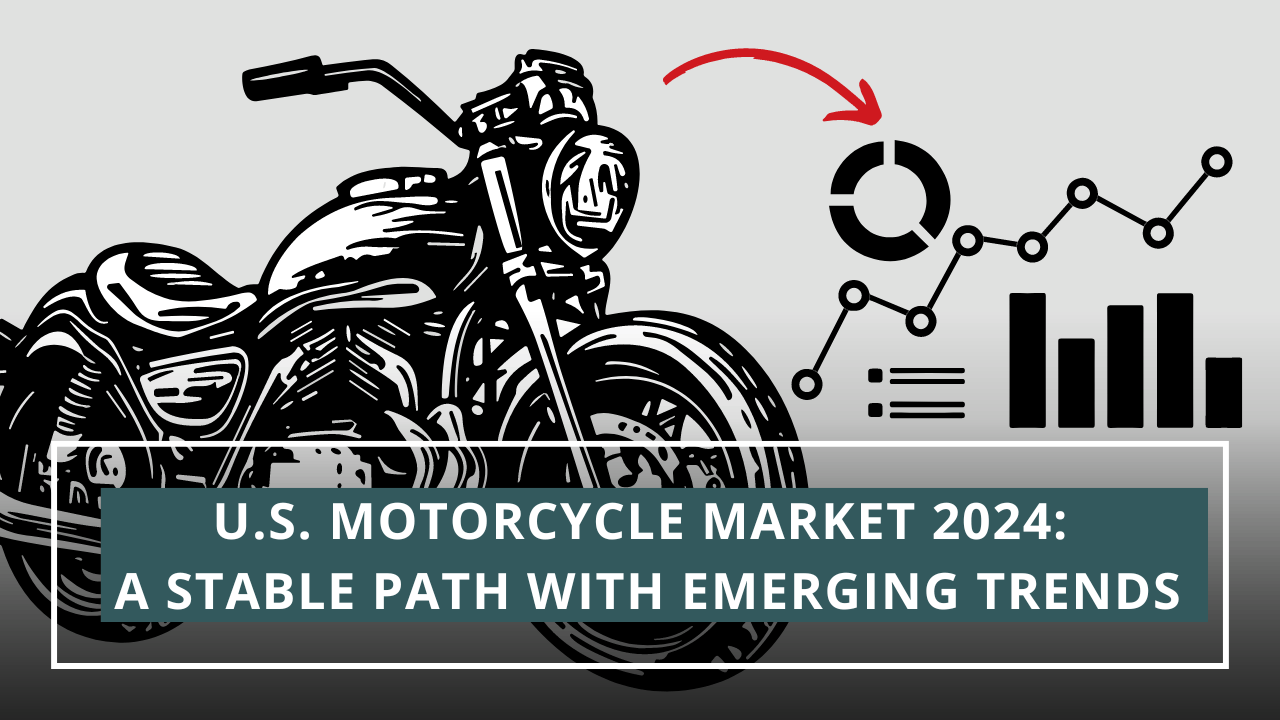U.S. Motorcycle Market 2024: A Stable Path with Emerging Trends
The U.S. motorcycle market has long been a symbol of resilience and passion, standing as one of the most stable markets globally. Unlike many other industries, which have been swayed by economic cycles, political changes, and global disruptions, the American motorcycle scene has remained remarkably consistent. For over a decade, annual sales have hovered around the half-million mark, a testament to the enduring allure of two-wheeled freedom in a country where open roads and a spirit of adventure are deeply ingrained in the national psyche.
2024 Market Overview
As we move through 2024, the market continues to evolve, balancing tradition with innovation. While legendary brands like Harley-Davidson and Honda continue to hold a strong presence, the entry of new players and evolving consumer tastes are quietly transforming the landscape. The market’s ability to blend time-honored traditions with fresh innovations is a testament to its enduring appeal.

The beginning of 2024 may have been unremarkable, but the industry managed to achieve a slight uptick in sales, reaching 323,091 units by mid-year, reflecting a 0.9% increase from the previous year. This growth, though modest, underscores the market’s inherent stability, even amid economic challenges.
Market Dynamics and Updated Data
Street motorcycles remain the cornerstone of the market, while scooters persist as a small, static segment. In 2024, street motorcycles accounted for 75% of total sales, while scooters remained at a stable 5%. For most Americans, motorcycles are more than just vehicles—they represent a lifestyle choice, embodying freedom and adventure rather than serving as a primary mode of transportation. Commuting on motorcycles remains relatively uncommon, with the majority of riders purchasing bikes for leisure and personal fulfillment.
Shift in Consumer Preferences: Exploring New Horizons
For decades, Harley-Davidson has been synonymous with American motorcycling, embodying the rugged, rebellious spirit that many riders sought. The brand’s dominance was almost unchallenged, with its heavyweight cruisers and touring bikes becoming cultural icons. However, as the motorcycle industry has evolved, so too have the preferences of consumers.
Diverse Product Offerings:
The introduction of new brands and models has expanded the choices available to consumers. Brands such as Indian, Triumph, and various Japanese manufacturers like Honda, Yamaha, and Kawasaki, now offer a wide range of motorcycles that cater to different riding styles and needs. From sportbikes and adventure bikes to lightweight, agile street bikes, the market now has something for everyone. This variety has encouraged riders to explore beyond the traditional offerings of Harley-Davidson, leading to a more competitive market.
Changing Demographics:
The demographic profile of motorcycle riders has evolved. Younger riders, women, and urban commuters are becoming a larger part of the market. These groups often seek bikes that are more affordable, easier to handle, and suitable for city riding—attributes that are not always associated with traditional Harley-Davidson models. As a result, brands offering smaller, more versatile motorcycles have gained traction.
Focus on Performance and Technology:
Modern consumers are increasingly interested in performance, technology, and innovation. Brands like Ducati, BMW, and KTM have capitalized on this by offering motorcycles with advanced features, such as sophisticated electronics, powerful engines, and cutting-edge design. This emphasis on performance and technology appeals to a new generation of riders who value these attributes over the classic, heavyweight cruisers that Harley-Davidson is known for.
Cultural Shifts:
The cultural perception of motorcycles is also changing. While Harley-Davidson once symbolized a rebellious, counter-culture lifestyle, today’s riders are more likely to view motorcycling as a hobby, sport, or means of personal expression. This shift has opened the door for a broader range of motorcycle types to gain popularity as riders look for bikes that align with their lifestyles and values.
Environmental and Economic Considerations:
With growing awareness of environmental issues, some consumers are turning towards more fuel-efficient motorcycles or even electric models. Additionally, the economic realities of motorcycle ownership—such as the initial cost, maintenance, and fuel—have led some riders to consider more affordable options than Harley-Davidson’s traditionally premium-priced offerings.
Electric Motorcycles: Slowly Gaining Ground
Although the U.S. offers some of the most generous incentives for electric vehicles worldwide, the electric motorcycle segment remains a niche market. However, the first half of 2024 saw a notable 55% increase in electric motorcycle sales, indicating a growing interest in this segment. This trend, though still emerging, suggests that electric motorcycles may gradually carve out a more significant share of the market as technology improves and consumer awareness grows.

Competitive Landscape
Honda remains the market leader, achieving a 4.8% sales increase in the first half of 2024, driven by its diverse lineup that appeals to both new and seasoned riders.
Harley-Davidson follows closely, finally seeing a positive shift with a 7.4% increase in registrations, a welcome recovery after several challenging years. The brand’s efforts to modernize its lineup and appeal to a broader audience seem to be paying off.
Kawasaki holds the third position, although it experienced an 8.9% decline in sales during the same period, reflecting the competitive pressures within the industry. The brand’s focus on performance-oriented models remains strong, but market dynamics are pushing it to adapt.
Competitor Analysis: U.S. vs. International Brands
In the competitive landscape of 2024, U.S. brands like Harley-Davidson and Indian are holding their ground against international competitors such as Ducati, BMW, and Honda. European brands are capitalizing on their reputation for high performance and cutting-edge technology, while Asian manufacturers continue to dominate the market with affordable, reliable, and versatile models.
For example, BMW’s R 1250 GS continues to lead the adventure bike segment, with sales growing by 5.3% in 2024, thanks to its advanced features and reputation for reliability. Meanwhile, Ducati’s Panigale V4 remains a top contender in the sportbike category, appealing to riders seeking high performance and distinctive Italian styling. These international brands are adapting to the U.S. market by offering models that cater to the evolving preferences of American riders, particularly in urban and performance segments.
Top 10 Best-Selling Motorcycles in the U.S. (2024)
- Honda CRF300L
- Sales: 14,562 units
The CRF300L continues to dominate the dual-sport category with its blend of off-road capability and street-legal functionality.
- Harley-Davidson Street Glide
- Sales: 13,947 units
A consistent favorite, the Street Glide is synonymous with American cruising, offering a balance of style, comfort, and power.
- Honda Rebel 500
- Sales: 12,783 units
The Rebel 500 remains a top choice for beginner and intermediate riders, known for its user-friendly handling and retro style.
- Yamaha MT-07
- Sales: 11,628 units
With its aggressive styling and responsive performance, the MT-07 is a top contender in the naked bike segment.
- Harley-Davidson Road Glide
- Sales: 11,105 units
The Road Glide is celebrated for its long-distance touring capabilities and distinctive frame-mounted fairing.
- Kawasaki Ninja 400
- Sales: 10,977 units
Popular among new riders and seasoned enthusiasts alike, the Ninja 400 offers sporty performance in a lightweight package.
- Suzuki DR-Z400S
- Sales: 9,874 units
This versatile dual-sport bike remains a strong seller thanks to its reliable performance both on and off-road.
- Harley-Davidson Fat Boy
- Sales: 9,460 units
The Fat Boy, with its iconic design and powerful engine, continues to attract riders seeking a classic Harley experience.
- BMW R 1250 GS
- Sales: 8,933 units
A leader in the adventure bike segment, the R 1250 GS is known for its exceptional versatility and advanced technology.
- Ducati Panigale V4
- Sales: 7,520 units
The Panigale V4 remains a top choice for sportbike enthusiasts, offering cutting-edge performance and Italian styling.
Transportation Solutions: Evolving with the Market
The vastness of the United States presents unique challenges for transporting motorcycles across different regions. Riders often need to move their bikes over long distances, whether relocating, attending events like motorcycle rallies, or purchasing and selling motorcycles across state lines. Historically, these logistical challenges required considerable effort, as standard vehicle transportation services weren’t always equipped to handle motorcycles with the necessary care and expertise.
However, the landscape of motorcycle transportation has evolved significantly, thanks to specialized companies like A1 Auto Transport. These companies have revolutionized how motorcycles are shipped, offering tailored services that cater specifically to the needs of both individual riders and dealerships.
Final Thoughts
The U.S. motorcycle market in 2024 is a fascinating blend of tradition and transformation. While the industry remains stable with steady sales figures, there’s a palpable shift in consumer preferences and market dynamics. Established brands like Harley-Davidson are finding ways to adapt to a changing demographic, while electric motorcycles and international competitors are gradually carving out their own space. With evolving technology, diverse product offerings, and a growing interest in performance and innovation, the road ahead for the U.S. motorcycle market promises to be both challenging and exciting. This article has provided a snapshot of where the market stands today and where it might be headed, offering valuable insights for enthusiasts and industry professionals alike.







